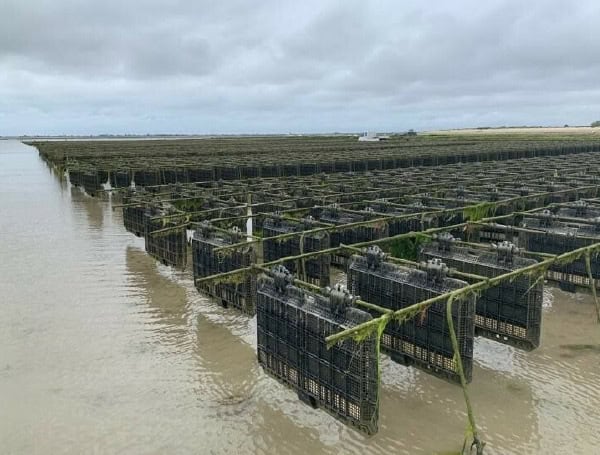
Florida’s oyster population has declined during the past 15 years because of overharvest, hurricanes, changing environmental conditions and more. In particular, Apalachicola Bay has seen a pronounced reduction.
“Oyster farming has been seen as a way to continue the supply of oysters because the wild population has been so overharvested,” said Roy Yanong, a University of Florida professor and Extension veterinarian at the Tropical Aquaculture Lab in Ruskin.
Oysters naturally grow at the bottom of marine or estuarine environments, but new technologies could allow oyster farmers to more efficiently grow and harvest oysters from the water column. On the bottom, they may get covered by sediment, and/or be eaten by predators.
Read: Disease-Resistant Wine Grapes Could Be Boon For Florida’s Viticulture
Water column leases give oyster farmers an opportunity to reduce those risks, but such methods are labor intensive and more expensive than traditional farming.
In a new Ask IFAS document, University of Florida experts outline three new technologies that may help Florida oyster farmers increase their harvests. None of these technologies is being used in Florida yet because they’re cost-prohibitive for now, but that might change in the future, say UF/IFAS experts.
The new review outlines these innovations, all of which aim to maximize oyster output while minimizing manual labor:
- Grain Ocean Roll Bag.
- Solar Oyster Production.
- FlipFarm.
Read: Florida Red Tide Update: No Karenia brevis Detected, No Fish Kills, Or Respiratory Irritation
The shellfish industry requires tremendous labor to meet consumer demands. Traditional oyster farming takes two years to grow oysters to marketable size. With the new technologies, you can grow oysters to marketable size in 1 to 1½ years, said Emily Caffrey, lead author of the new review.
The technologies allow farmers to incorporate the entire water column – the area between the surface and the bottom – to grow their oysters and automate husbandry to maximize production.
“You get the best water flow in the water column. If oysters sit on the bottom, algae grows on them,” said Caffrey, who earned her non-thesis master’s in fisheries and aquatics sciences at UF/IFAS last year.
She conducted her review of oyster culture methods under the supervision of Yanong, a Florida Sea Grant-affiliated faculty member in the School of Forest, Fisheries, & Geomatics Sciences.
Some oyster farmers in Maine, France and the Chesapeake Bay are already using the new technologies, but future locations where the new gear can be used will depend on the permitting agency.
“We believe the paper is important for describing and highlighting some newer technologies that may have applicability to Florida oyster culture, which perhaps may benefit from some of these,” Yanong said.
But their use depends on costs and regulatory challenges, he said. Additionally, more research is needed into the benefits of the technologies.
“I think the new technologies help to reduce labor and time for keeping biofouling down and allowing for better feeding and growth,” Yanong said. “But I’m not aware if any side-by-side studies have been run to look into traditional vs. newer, more automated methods.”
Please make a small donation to the Tampa Free Press to help sustain independent journalism. Your contribution enables us to continue delivering high-quality, local, and national news coverage.
Android Users: Download our free app to stay up-to-date on the latest news.
Connect with us: Follow the Tampa Free Press on Facebook and Twitter for breaking news and updates.
Sign up: Subscribe to our free newsletter for a curated selection of top stories delivered straight to your inbox.
